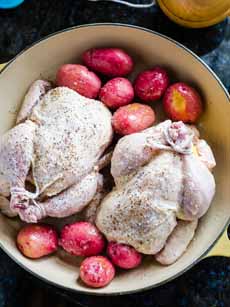TIP OF THE DAY: Cornish Hen (Cornish Game Hen, Rock Cornish Game Hen)
|
|
When we were growing up, our Nana roasted a chicken at least twice a week. But on weekends and for special occasions, it was Cornish game hen—now simply called Cornish hen. The original Cornish chickens are a large-size heritage breed* from the county of Cornwall in England. They are bred for their meat, since they are not prolific egg-layers. Cornish chickens, as well as crosses of Cornishes, are the most-used breed in the chicken meat industry. The hens take a long time to mature, requiring more feed/expense until they are ready for harvest. The American Cornish hen, also referred to as Rock Cornish hen and Cornish game hen, was bred in Connecticut in 1949 by Te (Alphonsine) Makowsky, who had grown up on a farm in France. After her husband retired from his manufacturing company in 1946, the couple moved from Long Island to Connecticut to start a chicken farm. It specialized in African guinea hens. After a fire destroyed the barn and the birds in 1949, Te Makowsky began cross-breeding chickens to try to come up with a bird that matures quickly, with an eye towards more breast meat. She came up with the idea of producing a small, plump “specialty” bird. Her idea was to breed the Cornish chicken—at the time the most popular breed in the world for broilers—with the American White Plymouth Rock chicken; hence the name Rock Cornish game hen. This combination gave her a chicken that could be harvested in less than five weeks, saving money on feed. It was petite—two pounds or less—making each bird one complete serving. It had succulent, tender meat, and a larger proportion of breast meat. By the 1950s, the Cornish game hen—which had been meant to be a temporary substitute for the guinea hen—became so popular that orders for it exceeded the guinea hen. [Source] Cornish hens have the same nutritional values and flavor as the larger broilers (some find the meat to be a bit milder). These hybrids are now sold as “Cornish hens.” The name “Cornish game hen,” which may have been a marketing description at retailers, has been dropped in favor of accuracy. Don’t confuse Cornish hens with these varieties: Your favorite sides! While many supermarkets may not carry fresh Cornish hens, check in the freezer section for Tyson Premium Cornish Hens. The all-natural birds have no added hormones, artificial ingredients or preservatives. |
|
|
Tyson shares these recipes with us: Roast, uncovered, basting frequently with butter for 1 hour or until the juices run clear when the thickest part of the hen is pierced and temperature on instant read thermometer reaches 180°F. If the hen weighs more than 1 pound 2 ounces, roast for an extra 15 minutes. ________________ *Heritage breeds are traditional livestock breeds that have been raised for centuries. In the modern industrial agricultural world, they are not cost-effective, and have been abandoned by mass growers in favor of other breeds or hybrids. Heritage breeds are still raised by small farmers, and are in demand by the finest restaurants.
|
||




